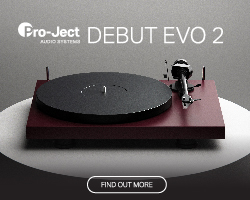AUDIOVECTOR R6 ARRETÉ LOUDSPEAKERS REVIEW
The Audiovector R6 Arreté Loudspeakers are a significant jump in price from their siblings the R3 Arreté, but is this extra financial outlay worth it? Stuart Smith finds out.

The R^ Arreté is a good looking loudspeaker with poise and style.
Here at HiFi Pig Towers, we’ve been using the Audiovector’s R3 Arreté as our reference “normal” loudspeaker in our main review system for the last couple of years as they delivered an exciting listen when listening for pleasure, as well as being well balanced and accurate enough for review purposes. However, I’d been itching to hear the Danish brand’s bigger offerings for ages and really wondered what extra, if anything, they would bring to the party. I also wondered if they would be worth the substantial extra financial outlay, for what on paper at least looks like a very similar loudspeaker. The R3 Arreté are available in the UK for £8725, whilst the R6 Arreté jump to £25000, both quoted without the Freedom grounding cables which I think is an essential addition to both these speakers – despite, as I said in my review of the R3s, the cable being voodoo. You can get the R6 Signature for £13200 and upgrade to the R6 Arreté as and when you want to via Audiovectors highly sensible upgrade program – send your speakers back, pay your money, and Audiovector will do the necessary to bring your speakers up to the next specification.
Now that jump in price is not inconsiderable and the speakers do look very similar indeed, though I was surprised at how much bigger the R6 actually are in comparison to the R3.
Both the R3 and R6 share the same Air Motion Transformer (AMT) tweeter and both have a couple of 6.5” drivers on the front baffle. So are the R6 Arreté just the R3s in a bigger box? Let’s have a closer look, shall we?
At this point, I strongly suggest that you read (or re-read) the R3 Arreté review as it will make what follows a lot more logical.
BUILD AND FEATURES
The review pair arrived in Italian Walnut, though a number of finishes are available as standard (Piano White and Black, Italian Walnut, and African Rosewood). You can pay a little extra for other finishes and the company have recently been showing off a glossy green that looks particularly splendid and is a little different from the norm. I’ve seen a few systems online with the Rosewood and Green finishes and they are my favourite…I think.
So, outwardly the R3 and the R6 look pretty similar. Both share the same teardrop design, both have a similar layout on the backplate, though the R6’s plate is carbon fibre, and both look to have s similar driver set up. However, initial appearances can be deceptive and we need to look inside the R6 to really understand where the big differences are.
The R6 Arreté stand 123.4 x 27.8 x 43.1cm (HWD) and are 91.5 dB sensitive (on paper, an easy speaker to drive) and are a 4.5 way loudspeaker. The latter sounds somewhat unusual, and it is, as will become evident.
The bass/mid drivers on the front of the R6 are both 6.5” Carbon models with “Titanium Coil Technology” using 3-poit suspended baskets and with the membranes being made from “cross-woven Aramid Composite Fibres” and are handmade in Denmark. The tweeter is the R AMT Arreté, the same as found on the R3 Aretté. Now, those of you that have flipped back in time and read the R3 review again will notice that the R6, as well as being physically bigger than the R3, have a couple of ports on the front of them, but surely that can’t be the only difference! Well, it’s all just a tad more complex than that and hidden from view inside the cabinets of the R6 you have another 6.5” internal bass driver and a downward-firing 8” woofer that are set up in an Isobaric (same pressure) configuration. Isobaric bass is nothing new and many will recall Linn’s Isobarik and Sara speakers that both used this system. The isobaric bass system, Audiovector call it the Isobaric Compound Bass system, couples the mass of the two bass drivers via the air trapped in the enclosure that they both share. So that’s one difference. The next difference is the inclusion on the R6 Arreté (and only on the Arreté version) of a rear-firing 3” paper coned driver. So, you get a bigger box with the same basic shape and construction as the R3 but with an extra bass system hidden away…and a rear-firing midrange driver – the latter being included to presumably enhance the presence of the speakers. However, the Aretté version of the R6 also adds “Nanopore Damping Material”, “Internal Shock Absorbers” and a “Carbon Terminal Plate” around the back.
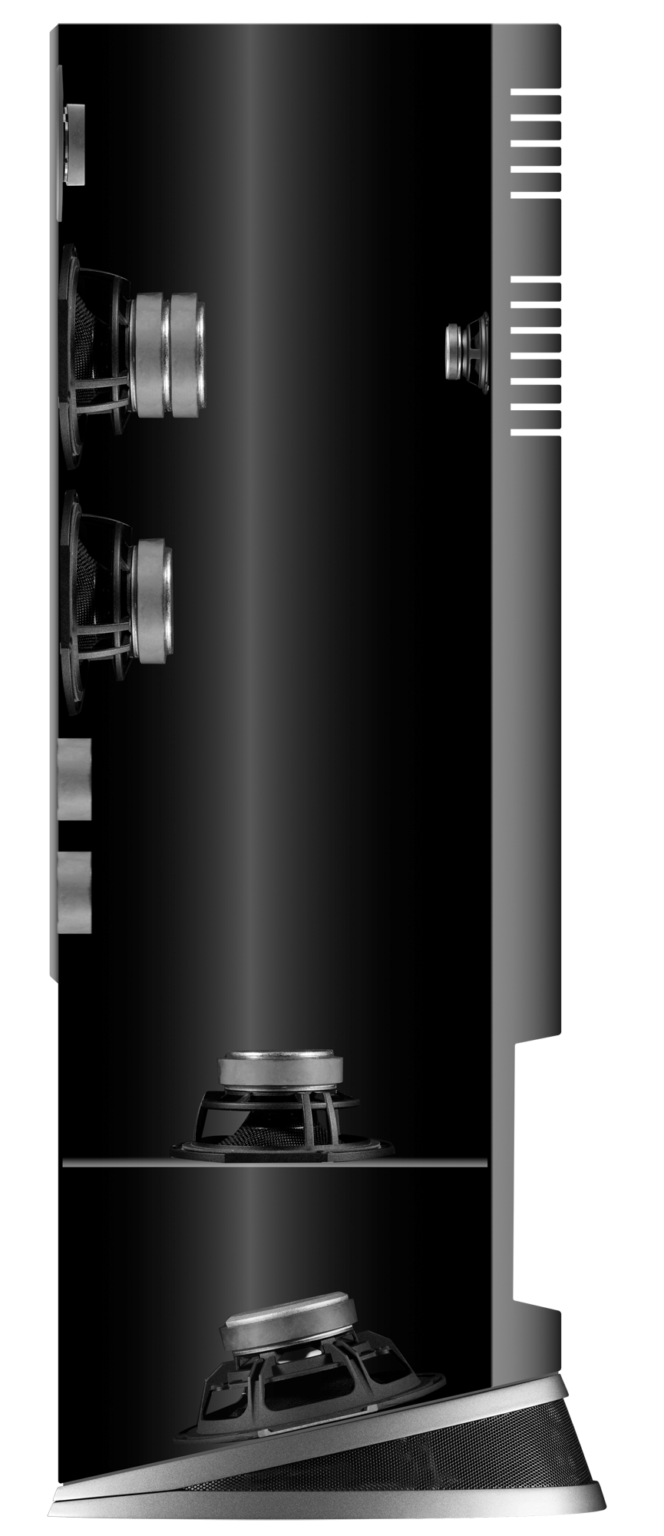
Inside cutaway to show the isobaric loading of the bass drivers.
So the biggie here for me is that Isobaric bass system which I fully expected to take the frequency response of the R6 to much lower than the 23Hz quoted by Audiovector for the R3…but they don’t, and the R6 also get a quoted response of 23 to 53000Hz. So if the frequency response is the same then surely you are better off saving yourself a few beer tokens and opting for the R3 Arreté – if we discount the rear-firing 3” driver that is trickled down from the much pricier R8 and R11s. However, life’s not quite that simple and those on-paper specifications are a tad misleading if you take them at face value – and adds weight to my ongoing argument that measurements of any audio kit only tell a fraction of the story.

A carbon fibre plate is an upgrade from the R3.
I’m going to waffle on about the supports I used for the R6 now for a little and so feel free to make a cuppa, or read on through the rest of this paragraph and be thoroughly enthralled by its content. The R6s come with a set of stainless steel spikes but I find spikes a total waste of time in our main listening room as we have a massive void beneath a suspended floor. My usual go-to solution has been the IsoAcoustic Gaia doodads that you screw in where the spikes should be – these worked a treat with the R3 but the ones I used for the R3 aren’t hefty enough to work with the R6 and so IsoAcoustic kindly sent out a pair of their larger Gaias. In the meantime I left the spikes on and popped the speakers on the Townshend platforms we have here. That worked OK to a point but I wasn’t convinced that the metal plate of the platforms wasn’t having an adverse effect on the bass. I tried this with and without the spikes and got the same effect. At this point it should be pointed out that Townshend do bars that don’t have the plate but we don’t have them to hand to try. Anyway, the Gaias arrived and were added to the bottom of the speakers but I still felt that the bass wasn’t what it should be and the very best solution I found was to stand the speakers with the IsoAcoustic Gaias in place stood on 1” thick marble platforms. With the latter set up I found that the bass seemed to snap into place, to be faster (no over decay) and any boom that there was disappeared. It’s this latter configuration that I used throughout the review.
Speakers were set up in the main room 2.75 metres apart and with the listening position 2.95 metres from their central point. They are about a metre away from the back wall and well away from sidewalls. However, apart from the footers and stands, I didn’t feel I needed to fanny about with positioning very much at all, though it did involve the usual lasers and whatnots. Initially, I did have them closer together by about 50cm but that extra width really did add make for a more expansive soundstage and so a modicum of messing about could be in order, though YMMV.
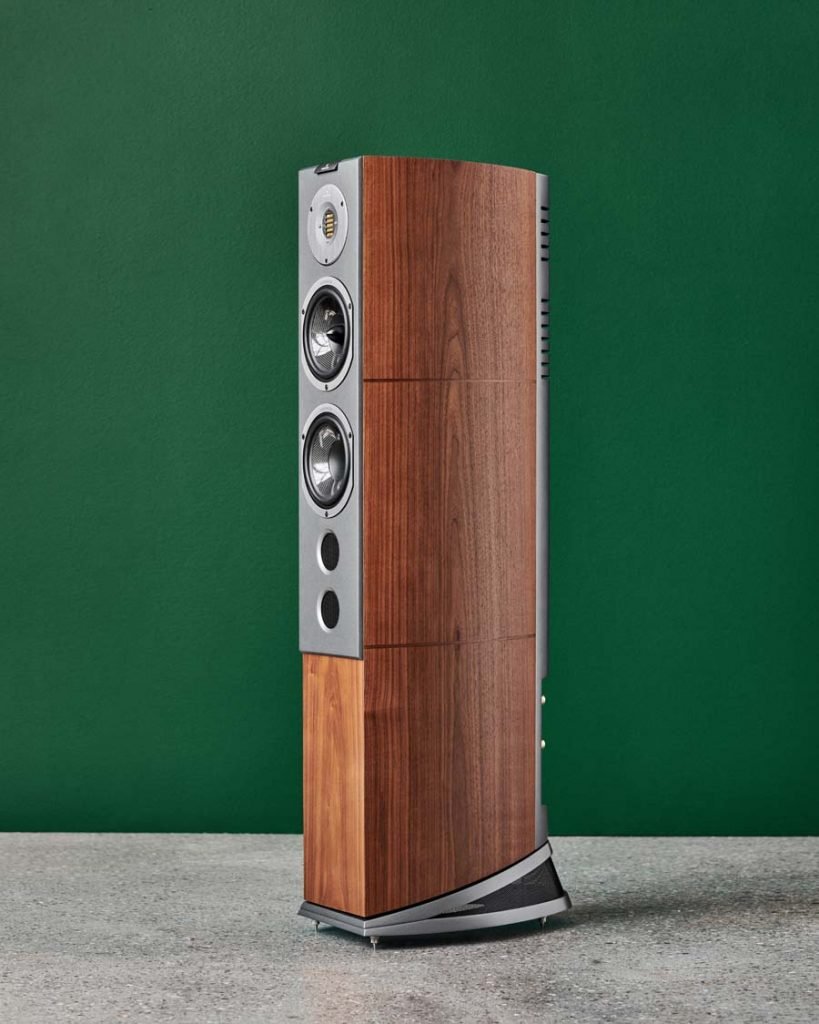
A side view showing the teardrop shape.
THE SOUND
Against all the odds I’ve started sometimes really enjoying listening to music at relatively moderate listening levels, and here the R6 really do come into their own. I’ve found, as many have I’m sure, that most speakers just don’t have the level of detail present to really get into the music unless you push them to realistic levels. However, the R6 just don’t feel like that and what you have is the full spectrum of frequencies only not as loud – I’m aware of that sounding obvious, but If you know what I mean you’ll know that it’s correct. This is most evident with the R6s on the bass end of things with there being no need to really listen out for the bass line in tunes – it’s just there and properly represented. This effect was really evident on tracks like Gil Scott-Heron’s Free Will and Speed Kills tunes, and where normally I’d want to crank the volume up, I just didn’t feel the need. Even at this low level, the bass lines were easy to follow and full of texture/tone. I suppose one way to describe this is that where I’d normally feel I was missing out a whole section of the tunes I now had everything there only just a bit quieter. There is a tightness and rightness to the bass guitar when played on these speakers that is hard to ignore. Is the bass over-dominant? Nope, it’s beautifully balanced and just part of the whole. I’m a bit of a bass junkie as regular readers will be aware. That is not to say I want the bass to be to the fore or overpowering – that’s really not the point! What is the point, in my opinion, is that there is coherent and articulate bass that feels “real” and that underpins everything else that is going on – lose this and, for me, tracks just fall apart. Likewise that rear-firing mid unit adds something at these lower volumes that feels right – the vocals on Gil’s compilation Ghetto Style just feel to be wonderfully “there” and in the room. Not forced, not pushed, just very natural, and like I said, there in the room. There is height to the vocal too and that adds to the illusion of Gil being stood there right in front of you. I could go on for ages about having listened to GS-H a lot on these speakers but the main points I wanted to make about the speakers at this kind of volume have hopefully been made clear.
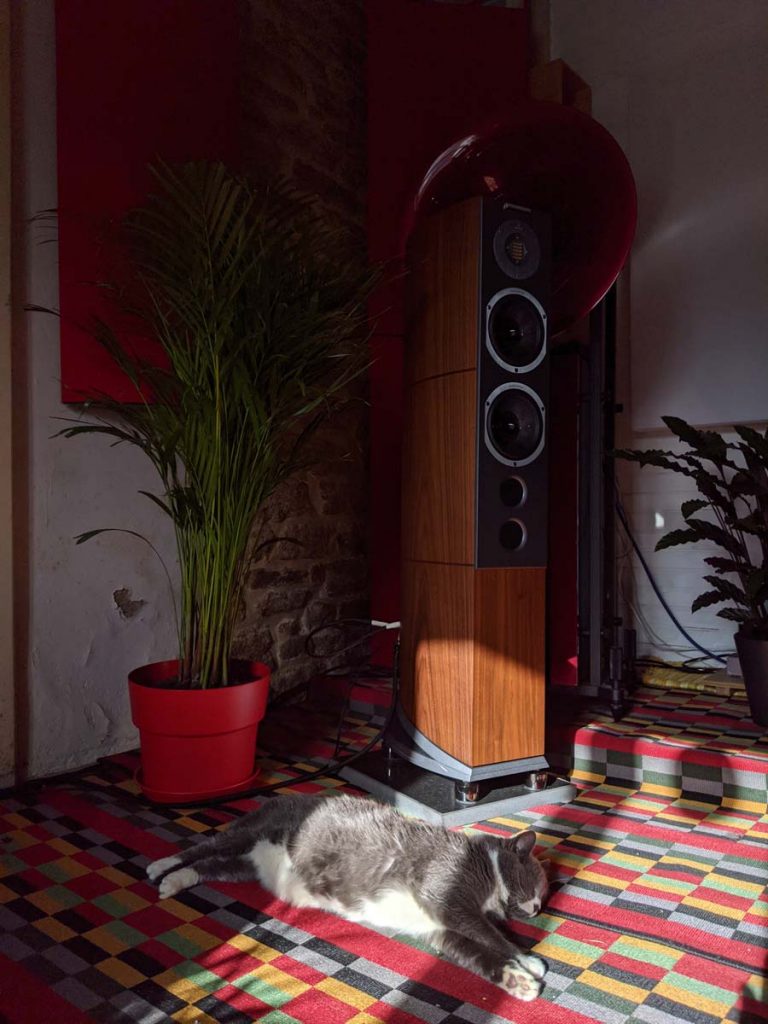
Not wanting to be outdone, Ali cat wanted to feel the bass up close.
But, dear reader, you know full well that we don’t always listen to music quietly and in a fashion that would make for great neighbour relations and is in no small part why we live in a detached house with neighbours far, far away. And so on goes Deadmau5’ W:/2016ALBUM (yep, that’s the title) and up goes the volume. The arpeggiatored synths at the start of the opening track 4ware fly around the speakers and out into the room and keep their integrity even when the rest of the track kicks off. The effect is that you can pick out individual bits of the track but without really having to dissect it, and, importantly, without it feeling like it is being overdone or forced. Some speakers that overplay this delineation can end up sounding false and as if you are listening to separate speakers – no so the R6. The tune just feels as though it washes over you in a similar way to the way the RaidhoTD2.2 I recently had the pleasure of reviewing. The track here is clearly made and designed to have certain psychoacoustic effects to mess with your perception and the R6 really enhance these effects. And then that bass! It pumps along with authority and weight and just underlines everything else that is going on. Bass kick has heft and welly but again isn’t overdone or overwhelming. The bass synth pad on the second track (2448) off this album sounds nothing short of majestic as it cuts below the soaring synth line that opens the tune. Again, there is a feeling of the tune washing over you with the AMT tweeter and the rear-firing mid really working well together to add space and dimensionality to proceedings, though still maintaining that “togetherness”. I’ll be honest here and say that I had real misgivings about the mid as I thought it would feel like a degree of artifice had been added to the music, but it’s not like that at all and Audiovector have done a great job of integrating the drivers to perform as a whole. These kinds of tunes are addictive on the R6s and here is where they stand out as being so much more than the R3s and where I’d draw issue with the R6 and R3s having the same bass response – again, suggesting to me that measurements, whilst having their place, only go so far in explaining what is really going on with a bit of kit. As I listen further to this (awesome) record I’m struck by the feeling of being sat in a bubble of sound. Audio Review Cliché Warning! These speakers are pretty holographic in how they present the music to the listener. Spatial stuff is pretty important to me when I listen to music and I want to feel immersed in the tunes both emotionally and physically – and I do with the R6, only, again, not feeling that this is unnatural or forced. Effects come and go in real three-dimensional space in a reach out and touch kind of way. And then the bass again! The bass is really hard-hitting and visceral but not overblown. It’s also tight and speedy with no overhang or one-note fartiness. These really are speakers that are right up my street in how they present themselves and the music I love.
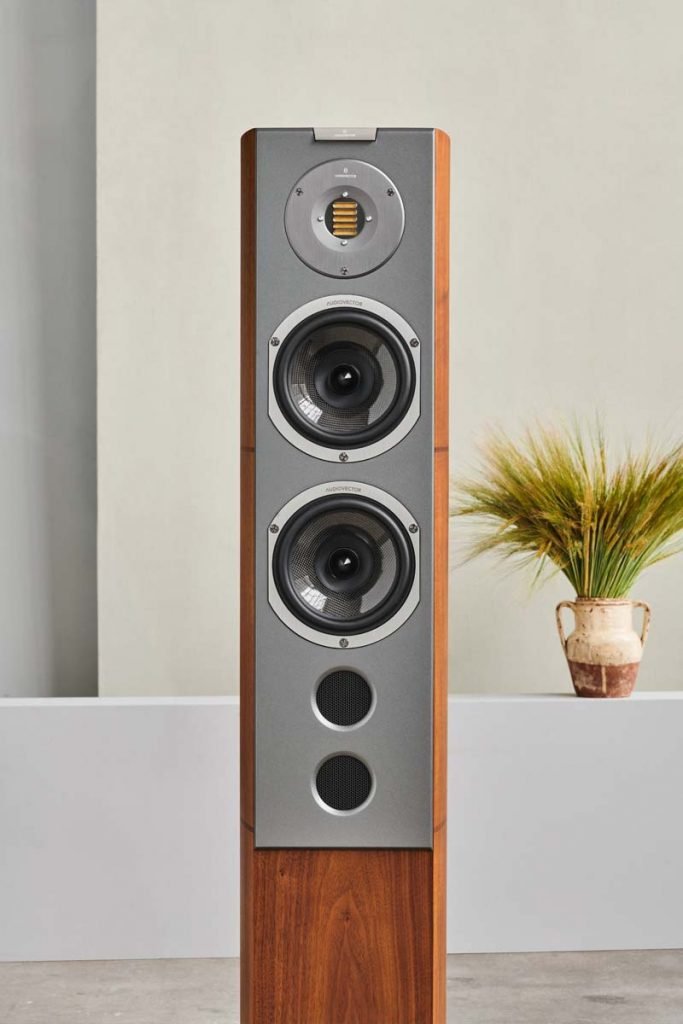
The R6 is a front-ported design.
So, talking about one-note bass, on goes Joey Beltram’s Energy Flash and it’s not actually the bass that grabs my attention here, though that is wonderfully done. What grabs me is the percussion noises with the huge reverbs on them. They could, and often do, sound messy and splashy, but with the R6 these percussion noises and the cymbal hits sound tight and correct…and obviously electronic. It also should be mentioned that here I’m listening loud, but I’m still getting the impression that the R6 aren’t even breaking a sweat. At these kinds of SPLs I’d be expecting the whole to break down in parts – it doesn’t and I’m just left wanting to listen to classic after classic. Fetch the glowsticks and Disco Biscuits.
A point here – I did try a few amps with the R6 and found that the usual Merrill Thor amps just didn’t cut it and sounded a little dry and, dare I say it, weedy in the bass. A big old Krell KST100 (fully revamped and upgraded by Krell in the US – thanks Walter) really brought the speakers to life and so when you think about partnering these speakers do think about the amp you are going to be driving them with. Now, this is a double-edged sword as I now want to hear what a big pair of Class A Krell monos could bring to the party. And it is a party! I did briefly try the R6 with a 25W Class A EL34 tube integrated from Synthesis (reviewed here) and the results were very good and with the amp controlling the bass here very well which proves to me that you don’t actually need monster amps, just the right amps.
So, if you listen to techno then you will love these speakers – I pretty much guarantee this and feel free to quote me on that, with the caveat that you need a quality amp to drive them! Not that they are a difficult speaker to drive and they will work with smaller amps, I’m talking about getting the very best from them and for me, I got that with the amp I mentioned. Again YMMV.

This amp, the Krell KST100, played wonderfully with the Audiovectors.
As I understand it, not everyone listens to techno and electronic music constantly, and the truth is neither do I, though I do go on about this style of music a lot and still maintain after all these years that techno is nigh on perfect for assessing the qualities of, particularly, loudspeakers. As with the Gil Scott-Heron tunes I played, I played all kinds of music on these speakers and never once did I think they were anything other than superb. Anouar Brahem’s Le Pas Du Chat Noir has the piano, guitar, and accordion sounding as natural as can be with a particularly strong feeling of that “in the roominess” I have mentioned before. The detail and sense of rightness in the presentation of this album was mesmerizingly real. This is small scale and intimate music and none of that feeling is lost with the R6s. Turning to larger-scale works and the Czech Philharmonic with Jiri Belohlavek playing Smetana’s Ma Vlast there is delicacy and beauty when called upon and then authority and scale when the music demands it. Dynamic and powerful were words I wrote down in my notes.
I have written about the Freedom Grounding Cable when I reviewed the R3 Arreté and whilst it is an extra cost it is a must buy and so I wish that Audiovector would consider including it in with every pair of Arreté as standard.
CONCLUSION
I put a post on the Audiovector Owners Group on Facebook that I was writing up my notes for this review and someone came back with “I gather your notes are pretty short…I liked them so much I bought them. End of review” (thanks Andrew Cairney for that) And it’s true, I could well have just done that as I did chat with Mads from Audiovector and bought the review pair. However, it’s a bit more complicated than that and here’s my thoughts.
I’ve reviewed the Audiovector R1, R3 and now the R6 and all are very good speakers. The R6 are a lot better than the R3 in their bass response and feel, and also through the mids with that extra rear-firing mid really adding a certain something to their presence. However, the R6 are considerably more expensive than the R3 and it is the R3 that for me represents the sweet-spot with regards to value for money vs performance. However, once heard the R6 are hard to walk away from and are highly addictive in how they get on with the job of playing whatever style of tunes you want to play through them.
Worth the extra money? That’s a hard one and down to your own priorities but I would say that if you love the R3s then don’t go listening to the R6s as your bank manager is likely to be wanting a chat – or you’ll be wanting to chat with your bank manager.
They represent, to my mind, all that I’m looking for in a loudspeaker. They are hugely dynamic with massive scale and presence that commands you to sit up and take notice. By turn, they are sweet and yet full-sounding at lower volumes.
AT A GLANCE
Build Quality:
Well put together and nicely finished
Nice looking in a conventional loudspeaker kind of way
I’d like to see them come with something other than spikes as standard
Freedom Grounding Cable is a must and should be included in the package
Sound Quality:
Dynamic and powerful at volume
Neutral sounding and balanced in their presentation
Detailed and insightful even at low volumes
That bass is something to behold
You need a good amplifier to get the very best out of them
Value For Money:
This is high-end audio and it’s a luxury. Yes these are expensive but so is the competition. In that light, the R6 are reasonably priced. However, they are not what you would call ostentatious looking and are pretty conventional on the face of it. Those looking for a speaker that is a visual talking point may want to look elsewhere.
We Loved:
Being able to fully enjoy tunes at low levels.
Being able to crank the volume up loud and still hear everything.
The extra presence and feeling of “in the room” the rear mid unit gives.
The airiness of that AMT tweeter
Tight and powerful bass presentation at all volume levels
A real sense of composure and being in control of the music
We Didn’t Love So Much:
I don’t like the plastic heel to the bottom of the speakers. It is easily scratched and I think it feels cheap.
We needed to replace the spikes with isolation products, though we have to do this with all speakers
Can be picky about amp, though this doesn’t mean you need to have a massively expensive or powerful amp to drive them well
Price: £25000, €28000, $35000
Elevator Pitch Review: The Danish Audiovector R6 Arreté are a 4.5 way design that incorporates a pair of 6.5 inch mids and an AMT tweeter. Inside there are 6.5 inch and 8 inch drivers in an isobaric unit for the bass, plus a rear-firing 3 inch mid driver. Fit and finish are good. Sonically there is a huge sense of scale to the speaker as well as intimacy and a real sense of being there with the recording. At the price they are not cheap, but for me they are worth it.

Stuart Smith
















































































